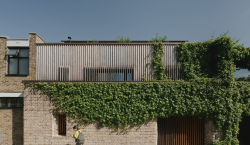Max Fordham House wins Residential Project of the Year 2021
26 February 2021
A project that’s especially close to our hearts has been recognised as Residential Project of the Year 2021 at yesterday’s CIBSE Building Performance Awards ceremony!
Max Fordham House, the ultra-low carbon Passivhaus home of our founder, has won the coveted prize, being especially praised for its design intent of zero heating by the judges, who were interested in the range of innovations and how they might be scalable and replicable to other projects.
The award celebrates the new-build residential building that most effectively demonstrates high levels of user satisfaction and comfort while delivering outstanding measured building performance.
Designed and built in collaboration with Max, bere:architects, Price & Myers and Bow Tie Construction, this three-bedroom Passivhaus home is an exemplar of collaboration, innovation and solution-focused design. Set in a tight, urban infill site, previously Max’s garden, the project shows what is possible and achievable as a technical concept for the housing sector.
“We're proud to have won this award. The building was designed to embody much of Max's thinking throughout his career and to perform exceptionally well. We are pleased to see this has been largely validated by the building's measured performance. Monitoring its energy consumption has shown how challenging it is to achieve the energy demand benchmarks of LETI in practice, even with a relatively low density of occupation and a building designed to achieve them.” – Ali Shaw, Principal Engineer at Max Fordham
People, and the things they do, generate heat all the time. Max has long held the view that this should be sufficient to keep warm inside a home on a freezing, overcast day; and that only by achieving this can a building be called “sustainable” in a UK climate. The brief was for a house with zero heating demand, to build on approaches Max had developed on various projects over the past few decades. The building’s thermal envelope, its ventilation system and its windows are designed so that the heat loss on a freezing cold winter’s day is no more than the heat generated by people living in the house.The high-performance thermal envelope completely wraps the building’s structure, eliminating thermal bridges. The envelope is also airtight, eliminating uncontrolled air exchange. The ventilation provision needed to provide healthy environments is then controlled and minimised mechanically, with heat recovery efficiency in excess of 90%.
"Max Fordham House – with its thermally massive structure, effective window opening areas, glossy white external finishes to window shutters and effective night-time ventilation – is also designed to stay comfortable in extremely hot weather. Its peak measured internal temperature was 28°C on 25 July 2019, when London reached 38°C during the record-breaking heatwave." - Stephen Matthews, CEO, CIBSE
The judges also noted the building’s maximisation of daylight and warm lighting. Occupied spaces are largely orientated south-east, which gives morning and midday direct sun, and a more characterful spectrum of light than diffuse daylight only. Artificial lights are generally off during the day.
Inclusivity aspects, and separation for ageing occupants, also impressed the judges. Plumbing connections have been built in so the upper part of the building could become a second dwelling should the ground floor become a self-contained flat without stairs. The flooring throughout is cork, which helps with acoustic character and offers some protection from falls.
Another aspect that was positively highlighted was the consideration of embodied energy, well ahead of current requirements.
In addition to being named Residential Project of the Year 2021, Max Fordham House won the RIBA London Sustainability Award 2019, a RIBA London Award and was shortlisted for the RIBA House of the Year 2019.
For more in-depth information on building performance, head to the Max Fordham House case study on our Net Zero Carbon Guide.





.jpg)